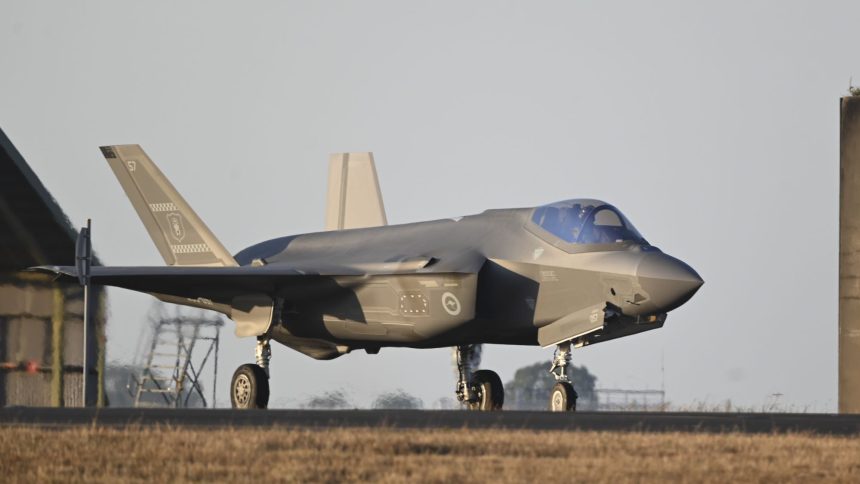In a significant display of interoperability, pilots from the US and UK seamlessly flew on Australian F-35s, demonstrating the flexibility to put any pilot in any F-35.
Enhancing allied interoperability and demonstrating the flexibility to generate combat power for future conflicts, U.S. Air Force, U.S. Marine Corps and Royal Air Force (RAF) F-35 pilots flew Royal Australian Air Force (RAAF) F-35A Lightning IIs in an “Interfly” exercise on Jul. 16, 2025, as part of the ongoing Talisman Sabre 25 exercise. A press release from the USAF said the “display of interoperability signified the first time USAF pilots flew 5th Generation aircraft belonging to a partnered or allied nation.”
The service identified the pilots achieving the “first-ever feat” as Air Force Reserve Maj. Justin “Spike” Lennon, an F-35 evaluator pilot from the 48th Fighter Wing based at RAF Lakenheath; Maj. Colby “Burn” Kluesner, F-35A evaluator pilot from the 388th FW at Hill AFB; Royal Air Force Squadron Leader Daniel “Goffy” Goff, F-35B instructor pilot; and U.S. Marine Corps Lt. Col. Johnny “Yardsale” Rose, F-35B instructor pilot. The USAF, USMC, and RAF pilots embedded with two of the RAAF’s F-35 squadrons, the No. 77 Squadron and No. 75 Squadron.
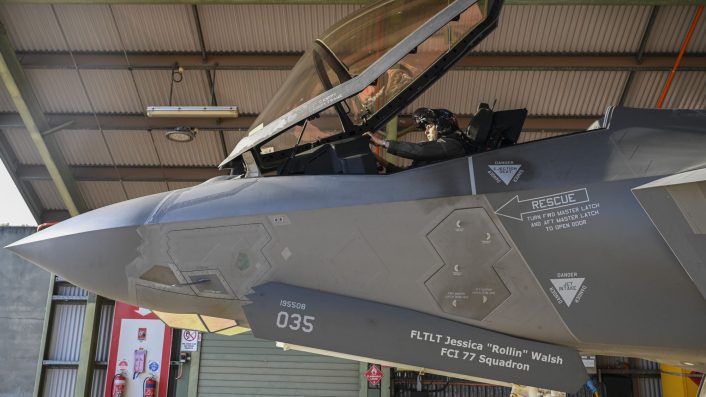
As one of the pilots later revealed in the release, the Interfly was not a planned or scheduled event, but rather something that possibly floated given the opportune moment offered by Talisman Sabre. The event follows other interoperability-enhancing activities like cross-maintenance of F-35s with RAAF and RoNAF (Royal Norwegian Air Force) that the USAF held in February and Apr. 2024.
The release further added that the RAAF built upon “its efforts in normalizing F-35 Interfly training among allies” through its 2023 “Lighting-X program,” exploiting the “mutual benefits provided to F-35 communities” for the Interfly program. The event is clearly different from the pilot exchange programs which see pilots embedding in foreign units and flying their aircraft for a longer assignment.
The Interfly event
The four British and American pilots received one day of “simulator training and academic courses,” following which the RAAF cleared them “to conduct training exercises during Talisman Sabre 25 using RAAF’s F-35 aircraft.” Maj. Lennon said in the release that the crew were “treated no differently than any other RAAF F-35 pilot during Talisman Sabre 25.”
“The only way anyone might know it’s not an Australian in the RAAF F-35 is the accent on the radio,” he added.
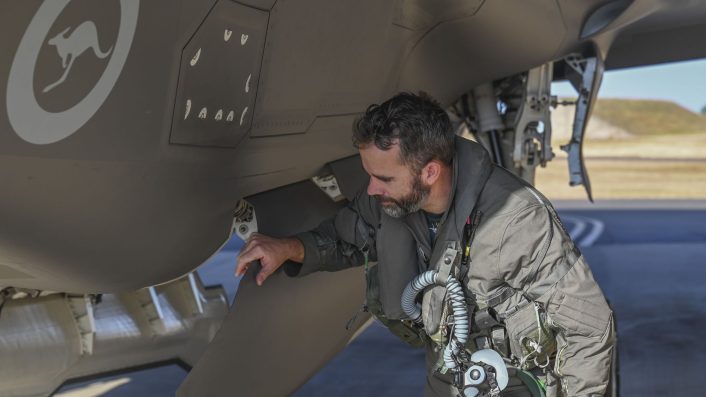
Despite the complete absence of language barriers, differences in communication, logistical protocols and military parlance and lingo are inevitable. Nevertheless, Lennon said in the release that “familiar training and equipment usage” like the F-35 does make adapting to another nation’s aircraft “easier than one might think.”
“Thanks to the commonality of F-35 variants, aligned training and operational practices between F-35 users, the flying portion is the easiest part,” Lennon explained. “Our visiting USAF pilots are able to execute and fly a RAAF F-35 no different from their Australian wingmen.”
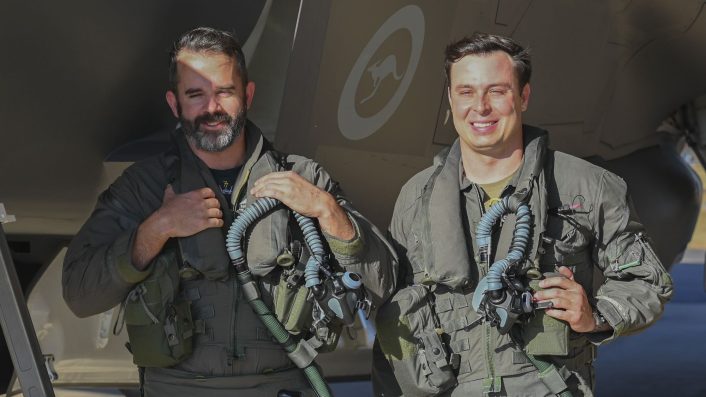
Images released on the DVIDS network showed Maj. Kluesner inside the cockpit of the RAAF F-35A and Sqn. Ldr. Goff conducting pre-flight checks in the Northern Territory, possibly at RAAF Base Tindal. “The recent effort in pilot interchangeability by multiple branches and nations in the F-35 community is aimed at preparing the U.S. and its allies for future conflicts long into the future,” the USAF release added.
The service has not specified how long the flight lasted and the nature of maneuvers and drills the USAF, USMC and RAF pilots conducted with the RAAF’s F-35As. The RAAF, RAF and the USMC too have not released any images or information on the Interfly event. While the RAAF and the USAF operate only the F-35A variant, the RAF and the USMC operate the STOVL (Short Take-Off and Vertical Landing) F-35B varrant.
There’s nothing better than flying together. 🤝
During Talisman Sabre 2025 the #AusAirForce, @RoyalAirForce, @USMC, @PACAF took to the world’s premier airspace over the Northern Territory.
TS25 provides #YourADF the opportunity to practice high-end warfighting. pic.twitter.com/IrD4B2AQpX
— Royal Australian Air Force (@AusAirForce) July 17, 2025
The RAF jointly flies and operates its F-35Bs with the Royal Navy, including embarking them on the RN’s HMS Queen Elizabeth and HMS Prince of Wales aircraft carriers, for uniform and easy logistics of the fifth generation jet. The trilateral cooperation between the three nations also extends to other platforms like the E-7A Wedgetail AEW&C (Airborne Early Warning and Control) aircraft, as an aircraft from the RAAF was used to certify it to be refueled by te KC-46A Pegasus early in April 2025 at Edwards AFB and the Mojave desert.
The HMS Prince of Wales and the USS George Washington aircraft carriers are also participating in Talisman Sabre 25. On Jul. 8, the HMS Prince of Wales hosted Marine Corps F-35Bs of Marine Fighter Attack Squadron-242 (VMFA-242), which were deployed on the amphibious assault ship USS America.
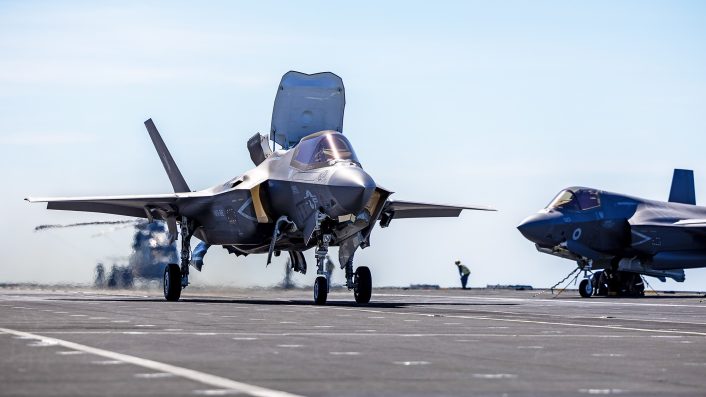
Complete, seamless integration for future operations
Lennon said Interfly enabled the USAF to train partner nations on weapons systems they have purchased, and conduct exchange assignments.
“However, until now the USAF has never performed international interfly on an ad-hoc basis,” Lennon explained. “This effort is part of a larger plan to normalize F-35 Interfly training with our allies. In the short term, Interfly events like this allow us to exchange information and best practices
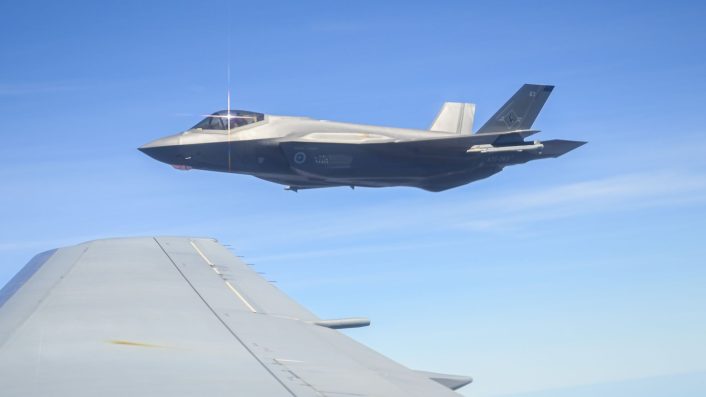
Long term benefits include “additional options for agility and versatility” for commanders in a future conflict. This is because a prolonged conflict would see airplanes being exempt from the limitations of human endurance on cognitive ability and fatigue from complex missions, strainful missions.
“Airplanes are capable of flying more hours a day than a pilot. Having the added flexibility to put any pilot in any F-35 and generate combat airpower anywhere in the world adds to the F-35 coalition’s lethality,” Lennon adds. Conducting unrelenting operations to dictate the tempo of war with the PLA, has already been envisaged with respect to CCA tactics in the western Pacific.
📍RAAF Darwin #ExTalismanSabre25
Bring the heat 🔥
Multinational industry at its best showing all participating nations are secure at home and strong abroad. More to follow…
19 nations, 35,000 personnel #StrongerTogether 💪
🌏 Ready to #FlyandFight ✈️ pic.twitter.com/gsGKSsnAqT
— Royal Air Force (@RoyalAirForce) July 21, 2025
“[The Lightning-X program] allows RAAF commanders to treat our coalition counterparts as RAAF aircrew when we consider things like medical, dental, physiological issues, egress systems and human factors,” said RAAF Squadron Leader Nicholas Reynolds, No. 77 Squadron executive officer. “It is a big win to be able to seamlessly integrate here at Talisman Sabre 25 with 77 Squadron.”

